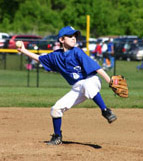|
Sports Medicine - How many pitches should my son throw? ׀ by John O'Halloran DPT, OCS, ATC, CSCS, Cert MDT |

Dr. John W. O'Halloran, DPT, PT, OCS, ATC, CSCS, cert MDT, is a licensed Physical Therapist and Athletic Trainer with over 24 years of experience in the field of rehabilitation. He is a board certified orthopaedic clinical specialist by the American Physical Therapy Association. He earned his post-professional Doctor of Physical Therapy from Temple University. Currently, Dr. O'Halloran is a director of physical therapy/sports medicine at Southeastern Orthopedics in Greensboro, North Carolina, co-owner of GOSMC Properties, LLC and owner of O'Halloran Consulting, LLC in Summerfield, North Carolina. He has also worked in a variety of settings including universities and hospitals. Dr. O'Halloran is also a former orthopedic instructor at the physical therapy assistant program at Guilford Technical Community College in Greensboro, North Carolina. In 1999, he became credentialed with the McKenzie Institute in the mechanical diagnosis and treatment of the spine. Dr. O'Halloran is also a certified functional capacity evaluator in the Blankenship Method. His unique evaluation and treatment skills make him a sought after clinical instructor for physical therapy and athletic training topics. He has spoken both locally and internationally on topics such as sports specific rehabilitation of the shoulder, spine rehabilitation and treatment of foot and ankle injuries. Dr. O'Halloran has studied orthopedic and sports therapy abroad in Australia and New Zealand. His post graduate work has included manipulative therapy. His wide range of clinical experience combined with his extensive knowledge in the fiscal management of physical therapy outpatient rehabilitation services make him a very knowledgeable and skilled instructor. For a complete listing of upcoming courses for John O’Halloran, click here. |
|
"How Many Pitches Should My Son Throw?" An educated personal story

In the spring of '06 I got caught up in the hoopla of today’s society
and had my 11 year-old son play in 40 baseball games.
Despite knowing the evidence that there is no way to predict
athletic achievement in high school, college or professional
by a child’s pre-adolescent athletic success, I felt extreme
pressure from coaches and friends that if he did not play on
these teams he would be left behind and lost in the shuffle.
Remember that there will always be that coach or parent that will say “when I played I threw everyday and my arm never hurt”, well times have changed, kids do not play catch and throw as much as they did 25-30 years ago and we are in the age of specialization which results in less long tossing or throws from the outfield that can build arm strength and cross train the throwing arm. You have to adapt and change with the times in order to recognize and hopefully prevent this very common problem our young baseball pitchers are experiencing.
Last revised: May 4, 2008 |
|
|
|
|






